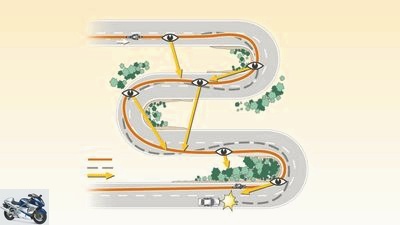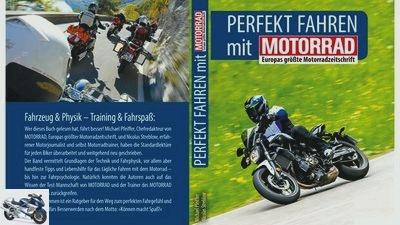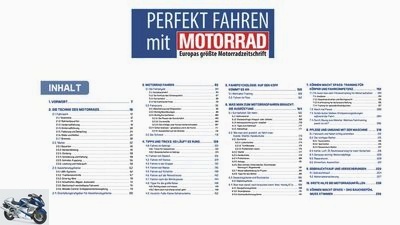Table of contents
- Book tip Perfectly driving a motorcycle The other motorcycle driving school
- Extract from the chapter “Tricks for switchbacks”

Tobias Rall
Sports & scene
Book Perfectly driving a motorcycle
Book tip Perfectly driving a motorcycle
The other motorcycle driving school
From the technology of the motorcycle to riding a motorcycle itself, driving tips, driving psychology, care and handling of the bike, as well as buying advice, equipment and training tips, everything is included on 240 pages.
Sebastian Quillmann
08/09/2018
At this completely different driving school, well-known speakers contribute their years of experience and give professional tips for better motorcycling. This book helps you to practice effectively with the machine yourself, to better understand the fundamentals of driving physics, to realistically assess yourself and your abilities, to train mentally and to sharpen your own understanding of technical processes.
Drive perfectly with MOTORRAD – buy book

Motorbuch Verlag
»Drive perfectly with MOTORRAD«
“Perfect driving with MOTORRAD” was modernized by Michael Pfeiffer, editor-in-chief of MOTORRAD, together with co-author Nicolas Streblow, and is now available in a revised and updated edition to reflect technical changes in motorcycle construction.
You can order the book here for 19.95 euros: www.motorradonline.de/perfekt-fahren
Extract from the chapter “Tricks for switchbacks”
For many flatland residents, they become a nightmare the first time: serpentines or hairpin bends, which the Alps are rich in. And yet, serpentines can be mastered with pleasure if you observe a few decisive rules. Curve technique and visual guidance are important. Again, the technique of undercutting is used here (see section »Correct cornering« in Chapter 3).
The curve is approached as far outside as possible, and especially in left-hand bends, we make sure that at no point does the head protrude into the opposite lane. Except for the oncoming lane, however, the line sometimes takes us in right-hand bends, especially when the inside is very steep. But I have to be able to see well on this line and be ready to pull inward in a flash. Because this safety line is only safe in right-hand bends as long as staying out of the way actually brings a visual advantage. On particularly narrow passes, along the rock face, with dense vegetation or in completely confusing switchbacks, however, the narrowest line is recommended, so stay on the far right in both right and left bends. Otherwise you could unexpectedly be faced with an extra wide coach or truck.
The pushing style has proven itself: With the upper body upright, the machine is pushed down using the handlebars. From the southerners you can also confidently copy the use of the horn to draw attention to yourself in the narrow, confusing angular work. Look up and down in front of and also in the serpentine. Actively turn your whole head again. This is the only way to identify oncoming vehicles in good time. Depending on the clarity of the serpentine, choose the right line, i.e. either undercut or, if necessary, the narrowest line in combination with a reduced speed.

Table of contents of the book “Drive perfectly with MOTORRAD”.
However, undercutting – i.e. late turning into the curve – offers many advantages. First of all, that we significantly reduce the risk of being “carried” into oncoming traffic or into the ditch at the exit of a curve. And those who approach the serpentine at a relatively slow cornering speed, which is why the motorcycle can be stabilized quickly with very little gas.
Alternatively, you can regulate the speed with the rear brake; leave the gas slightly open. This technology looks extremely elegant on serpentine stretches and also relaxes because the annoying load change jolting that occurs when opening and closing the gas is eliminated. On serpentines downhill, it also helps to pull the clutch at the apex, upshift and then use the accelerator to re-engage in the next higher gear. Even so, the disturbing load change shock, especially with harshly tuned, large two-cylinder engines, is easy to prevent, very pleasant and, above all, a gain in safety, especially in wet conditions.
Before the big alpine tour, it is advisable to practice something in the lowlands: draw a narrow figure eight or mark it with pylons / plastic bottles and set the pace not only with the throttle but also with the rear brake. A sloping parking lot would of course be ideal for this. The most important tools for tight and steep curves in no matter which mountains are, however, still the consciously trained eye guidance around the curve and the safety line adapted to the speed and the environment.
Related articles
-
Driving report Neckarsulm motorcycle from 1902
motorcycles Driving report Neckarsulm motorcycle from 1902 Driving report Neckarsulm motorcycle from 1902 At the origin 1901 and 1903 – the beginning of…
-
Motorcycle license costs classes A2 driving school forms
Natalie Diedrichs 9 pictures Bilski 1/9 The motorcycle license is not only a permit to drive on public premises, but also for many people the ticket to…
-
No new basis for motorcycle driving bans
Motorcycle noise Debate about the volume of motorcycles Ralf Schneider counselor traffic & business No new basis for motorcycle driving bans Amendment of…
-
Driving tips: Warm up the motorcycle properly
jkuenstle.de counselor workshop Driving tips: Warm up the motorcycle properly This is how it works: Warm up the motorcycle properly How to get your bike…
-
Driving report electric motorcycle eROCKIT
Package 12th pictures 1/12 Erockit 2/12 Erockit 3/12 Erockit 4/12 Erockit 5/12 Erockit 6/12 Erockit 7/12 Erockit 8/12 Erockit 9/12 Erockit 10/12 Erockit…
-
DVD on motorcycle driving safety
Sports & scene DVD on motorcycle driving safety DVD “Motorcycles ride well and safely” Price reduced to 9.90 euros Motorcycles ride well and safely…
-
archive counselor technology & future Lateral and circumferential forces when riding a motorcycle – driving physics when riding a motorcycle About…
-
Nicolas Streblow counselor Driving experience & Driving tips Motorcycle driving training Motorcycle driving training, videos, links From theory to…
-
MOTORCYCLE tips for racetrack training
jkuenstle.de counselor workshop MOTORCYCLE tips for racetrack training Tips for newcomers to the racetrack Always nice and slow You’ve got your hands on…
-
The right tire choice for a motorcycle
Markus Jahn 26th pictures MOTORCYCLE 1/26 On the way on alpine passes? That’s how it works! MOTORCYCLE 2/26 Seductive winding curves with risk. The…